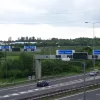How wide is the widest motorway? It might surprise you to learn that the widest motorway in the UK was opened in December 1970 and its incredible width hasn't been surpassed since then. There are a total of seventeen lanes side-by-side at its widest point, plus eight full-width hard shoulders. It's enormous.
The reason you might not immediately bring it to mind is that it's not where you might expect it: not on the sprawling M25, for a start, and not on the extravagant M8 in Glasgow. In fact it's on the often-overlooked M61, north-west of Manchester, as the motorway passes through a complex of sliproads called Worsley Braided Interchange at a place called Linnyshaw Moss.
The verges are very wide and the trees have grown quite tall now, but all seventeen lanes do run side-by-side and all form part of the same motorway. These photos — taken way back in May 2005 — show some of this unique junction from above.
A short walk across the fields from Linnyshaw brings us to this footbridge. It doesn't look very special from here, but the view can be deceptive. It's nearly 200m long, and it crosses an enormous complex of motorway sliproads.
At the point the bridge crosses Worsley Braided Interchange, there are just four parallel carriageways, but it offers a good view west to the point where they split into eight separate roadways. The southernmost carriageway is this one, which comes from Salford and the A580.
At the other side of the bridge, the same sliproad has grown two more lanes and splits to form two separate sliproads. These outer carriageways, connecting to the A580, are technically the mainline of the M61, while the wider motorway in the centre is just considered to be linking sliproads to the M60.
The next roadway the bridge crosses is the central pair of carriageways, which run from the M60 to the A666 into Bolton. Again, just west of the bridge, they split into separate sliproads, and the one on the left begins to descend gently to cross one of the sliproads in the previous picture. This crossover is the "braiding" that the name of the junction references.
Looking in the same direction from the middle of the bridge, the full scale of the junction becomes apparent, and the two crossover bridges are visible in the distance. There are seventeen lanes side-by-side between the point where the sliproads diverge and the crossover bridges, but it's hard to get them all in one picture.
In the opposite direction, the two central carriageways form a dual four-lane motorway heading towards the M60. This looks wide enough as it is but there's plenty more motorway capacity on separate roadways hidden on either side.
A closer look at the central carriageways as they approach the M60. These may be the UK's widest sliproads, given that they aren't formally part of either the M60 or M61. Construction drawings show them just as connecting roads.
A bit further along the bridge, one of the crossovers is visible. Bridge technology in the late 1960s made very oblique skew crossings difficult and expensive, so instead the crossovers were built as "galleries" — long fake tunnels. As a result, this bridge is 150m long, even though it only exists to allow two lanes of traffic to pass below another two lanes of traffic.









